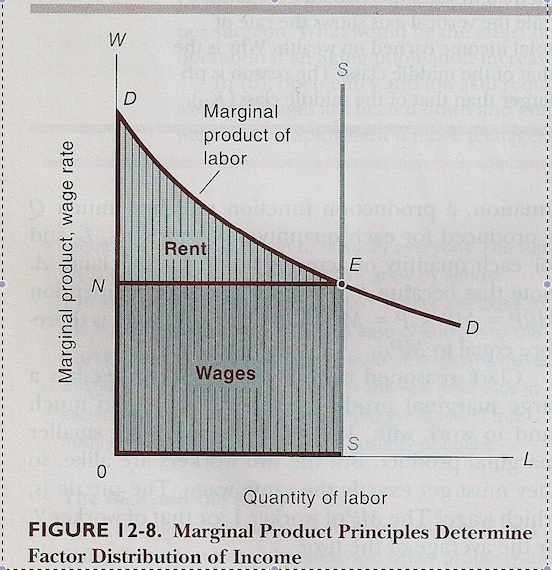Democracy Against Capitalism: Competing Stories About Wages
Ellen Meiksins Wood’s book Democracy against Capitalism, tells a story of capitalism at odds with the story economists tell. At the root of this is her view that we make a big mistake when we separate politics from economics. Here’s an example, summarized from three prior posts, one at Emptywheel, and this one and this one at Naked Capitalism. The original posts give more detailed discussions.
Chapter 12 of Samuelson and Nordhaus’ intro textbook Economics (2005 ed.) is titled How Markets Determine Incomes. They rely on marginal utility theory, invented by William Stanley Jevons, an English mathematician and economist and described in his 1871 book The Theory of Political Economy discussed here. Their explanation uses this chart. P. 238.

The y-axis is the marginal product of labor, with all other inputs held constant. The x-axis is the amount of labor, here the number of employees. We treat the labor as continuous so we can have a nice smooth curve, but in the real world it would look like a flight of stairs. The authors tell us that the employer will add workers until the marginal increase in revenue from the last worker is zero. They tell us that the bottom rectangle is wages, and the top triangle-ish shape DEN is rent. That’s because they are basing their explanation on John Bates Clark’s model from about 1900, and the idea is that this chart describes a farm. But they mean that this works for the economy as a whole, so it includes all workers on one hand, and all capitalists, that is, those who own the factories, smelters, coal mines, etc. on the other. This is their discussion:
Clark reasoned as follows: A first worker has a large marginal product because there is so much land to work with. Worker 2 has a slightly smaller marginal product. But the two workers are alike, so they must get exactly the same wage. The puzzle is, which wage? The MP (marginal production) of worker 1, or that of worker 2, or the average of the two?
Under perfect competition, the answer is clear: Landlords will not hire a worker if the market wage exceeds that worker’s marginal product. So competition will ensure that all the workers receive a wage rate equal to the marginal product of the last worker.
But now there is a surplus of total output over the wage bill because earlier workers have higher MPs than the last worker. What happens to the excess MPs…? The rest stays with the landlords as their residual earnings, which we will later call rent. Why…? The reason is that each landlord is a participant in the competitive market for land and rents the land for its best price. 237-8, emphasis in original.
Clark saw this as the result of the Natural Law, and pronounced it just. This is the model taught to generations in introductory economics. The logic seems questionable, but it doesn’t matter because it isn’t how things actually happen, as I demonstrate in the linked posts.
How would a Marxist like Wood describe this model? She divides society into two groups, the producers, in this case, the farmers, and the appropriators, in this case the landlords (ignoring detail), or the workers and the capitalists. At an earlier part of the history of this society, the land was handed to the landlords, or they took it violently when government was fragmented and power represented government. Wood is talking about England, but something similar happened in the US. As a result, the producers, here the farmers, were separated from the means of production, meaning the land and perhaps some of the tools and animals needed to grow crops, and the landowners were able to expropriate the surplus created by the producers. This is a rough description of what Marx called primitive accumulation (again ignoring details and not precisely following Wood).
Primitive accumulation didn’t happen by accident. It was done by some form of coercion by some sort of ruling class. Gradually the ruling class consolidated into states, and the process continued through the arms of the state. As an example, consider Polanyi’s description in The Great Transformation of the process of “enclosure” as it was called in England.
Turning to the chart, we ignore the marginal productivity stuff and treat the line NE as the level appropriators currently pay the producers. It is as low as the appropriators can make it, using both their control of the state, and their control of the process of production. If you have any doubts about that, read the discussion of the Phillips Curve and especially a paper by Simcha Barkai here. The capitalists appropriate the triangle DEN, which represents the surplus labor, for themselves.
As always, the disposition of surplus labour remains the central issue of class conflict; but now, that issue is no longer distinguishable from the organization of production. The struggle over appropriation appears not as a political struggle but as a battle over the terms and conditions of work. Kindle Loc. 804-806
The organization of production is controlled by the appropriators with the coercive assistance of the State as needed. If the producers were smart, they would struggle with the appropriators over that surplus. They’d elect governments that would take their side in the struggle over the allocation, they’d resist and force change. There is nothing but political power that requires payment of all of the surplus labor to capital.
So now we have two stories. To me, the Samuelson/Nordhaus/Clark story is dumb. It takes the economy as a given, as if things had always been this way. In other versions of their story, we get a few shards of carefully selected history that pretend to find seeds of capitalism in earlier times. Mostly, though, it’s a vision of capitalism as an inevitable and fixed system as available for study as a cadaver.
In addition, this story makes the outcomes seem pre-ordained, and leads people to think that interference with the process is both useless and somehow dangerous, certain to produce even worse results. And, it’s a just-so story: all the numbers appear to come out in perfect equilibrium as if by magic.
Wood’s story is easy to understand. It’s based in history, none of that man-made natural law mumbo-jumbo. It doesn’t call for absurd assumptions to make everything work out beautifully. It’s easy to see how this story can motivate action, and, of course, reaction. And here’s the key point: it’s easy enough to tell the this story without direct reference to Marx.

